The Castle and Krug
An Essay on 'Last House on the Left' (1972)
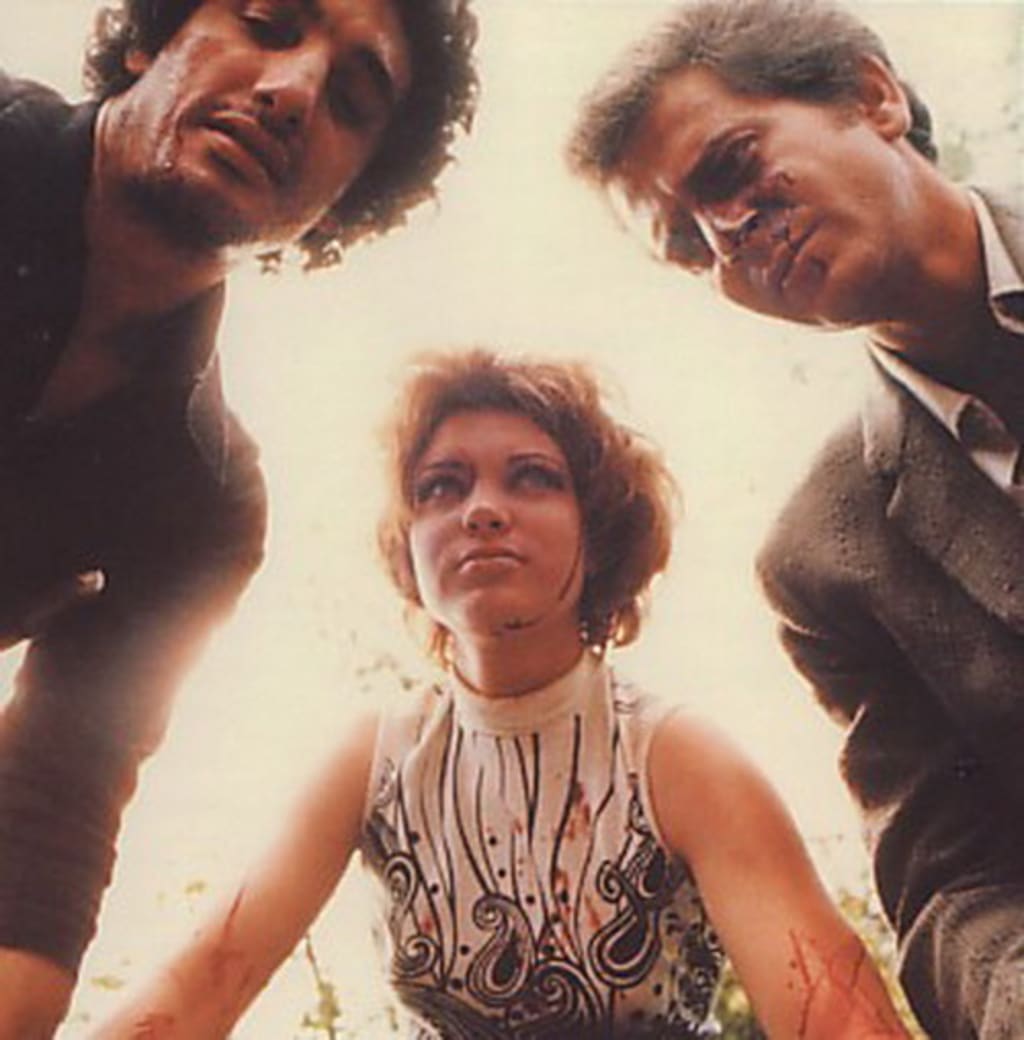
Back about a million years ago, when my buddy Buff and I used to pedal our badass selves around Gas City, Indiana, in and out of what was, at the time, called "video cassette shops," the order of a hot summer's day almost invariably involved finding the woodsiest, foulest, most rotten el cheapo exploitation classic we could lay our hands, and a dollar-fifty in rental fees down upon.
To that end we saw a mind-numbing succession of barnyard atrocities—cinematic dreck; hell, actually a little worse than that. Stuff that is eminently forgettable and forgotten. But, also, an occasional gem. One such film (gem, classic, masterpiece, oddity) director the late Wes Craven's directorial debut, the shocking, (by turns revolting and oddly comic and even poignant) Last House on the Left (1972), is an artistic statement that actually touches a nerve considerably more sensitive in your author than what its exploitation genre genre, would suggest. This is because, to me, its sub-textual subtext actually represents the death of something indefinable, something that was quintessentially American, that was killed off in the bloody miasma brought on by the Vietnam War, and the cultural revolution of the 1960s, in the era leading up to my birth in 1976.
It is a film whose themes, as well as remarkable soundtrack, both echo a kind of growing despair, a sense of the hopelessness of the Eisenhower Era: dreams of an America of white picket fences, green lawns, station wagons and badminton; miniature golf, department stores, and Fourth of July picnics... those things remain as leftovers of a world that was, of course, but something of the era of beehive-haired old women and ice cream socials is long, long gone, a victim of either the progress or degeneracy of the encroaching years, depending on your perspective.
You could argue it was all false: a carefully-cultivated facade that, beneath the surface of which, concealed many ugly and terrifying things: racism, misogyny, domestic and child abuse, war profiteering, and blind, unquestioning obedience on the part of the dumbed-down masses. And, you would be correct, my friend.
Still, in much the same way that a dream is supernal and eternal, in the way that it sustains our spiritual equilibrium, holding for us a crystal moment in time, a piece of poignant perfection; holding back the night of our own dissolution, our deaths, our inevitable end writ into the fabric of our being; those false days of a naive childhood, the smell of backyard barbecues, and catching lightning bugs in the gentle summer evening breeze seem timeless; call it: "American Elysium." At any rate, it's gone now. What is left is the soulless husk, a pale shadow of What Was.
But, now I am running far afield. To the movie.
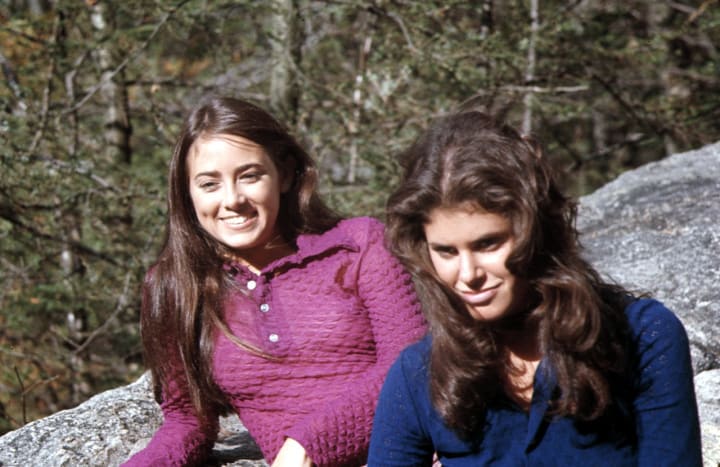
Mari Collingwood (Sandra Peabody) and Phyllis Stone (Lucy Grantham) head out to the ghetto to see a hard rock concert. They are kidnapped and abducted for a night of horror and death, instead.
"I Thought You Were the Love Generation!"
The plot, derived from Ingmar Bergman's The Virgin Spring (1960), which was, in turn, derived from a Swedish folktale about "Tore's Daughters," is as brutal and simple as any true crime happening documented for cheap exploitation purposes, in sordid supermarket paperbacks going back decades. It is so obvious, it has probably transpired on many occasions down through the years.
Mari (Sandra Cassell), just coming of age, receives from her father, Doctor Collingwood (soap opera actor Gaylord St. James), a special present of a peace symbol necklace. This is an important plot point later on. Mari, who has just finished eyeing her steadily developing breasts in the mirror, fresh out of the shower, spars comically with her father and mother (Estelle Parsons), not only about her choice to go without a bra, but about her choice to accompany Phyllis Stone, a girl from the "wrong side of the tracks," to an Alice Cooper-like hard rock performance by Blood Lust; a band reportedly known to dismember live chickens when they play.
"I don't understand it, all that blood and violence. I thought you were supposed to be the 'Love Generation'!" bewails Estelle Collingwood, Mari flipping her the peace sign sarcastically. Phyllis Stone later shows up, informing the concerned, bourgeois parents cheekily, "My parents are in the iron and steel business." When Doc Collingwood comments on how interesting it is they should be in "iron and Steel" both, Phyllis says, "Yeah, well my mother irons, and my father steals!"
Both then are out the door. The Collingwoods live out in the country, upstate New York, but Phyllis, of course, is from "that slum," in NYC, a place Mari thinks of as "dirty." Phyllis protests, using the current slang, that it's just "funky." Both stop to drink some wine. Mari fantasizes about a boy named Rodney and wonders what it would be like to be a groupie for Bloodlust. They stop for ice cream, the car radio giving a cliche urban legend-style special report about escaped maniacs.
Then, we meet the maniacs.
They are the ineffectual, wimpy heroin addict Junior (comedian Marc Sheffler), and his father Krug (actor and musician, the late David Hess, who composed the incredible soundtrack), and they are coming out of a liquor store when we first see them; Krug stops to bust a kid's balloon with his cigar.
They are escaped convicts, and Krug is wanted for the triple slaying of a priest and two nuns (!). They are joined by Weasel (porn actor and producer Fred Lincoln), a sexual deviant who was in prison for child molestation, and Sadie (actress and television producer Jeramie Rain, who was once married to Richard Dreyfus), described as "young, strong, animal-like"; she is said to have kicked a German Shepherd police dog to death.
Sadie looks like a gun moll from a John Waters film, with somewhat wild, punk hair and make-up. Weasel, by contrast, looks like a sleazy character from a Sixties cop show; Krug looks like a tough, inner-city heavy or pachuco, and Junior is the younger mirror of him. All of these people look as if they wandered in from an even earlier era.
Sadie's name, conspicuously, was borrowed from the alias of Manson Family murderess Susan Atkins, whom Jeramie Rain portrayed in an off-Broadway play. Small touches such as these set the tone for later mayhem.
Mari and Phyllis, transgressing in a way they will pay for with their lives, are out looking to "buy some grass" before the concert. Junior has been sent out by Sadie and Krug to find a "couple of more chicks," for "equal representation," so Sadie will not have to sexually service both Krug and Weasel alone. Junior tells the girls he has an ounce of "good stuff" that is "Columbian," and that it is dirt cheap. The girls go back with him to the tenement apartment slum (unfurnished, everyone seems to sleep on the floor), where the girls are immediately captured and held prisoner.
The audience gets a taste of what we're in for when the personalities of these sadistic felons is gradually exposed—Weasel and Sadie are immediately sexually aroused by the girls, and Junior, just happy his father has provided him with his fix, sits in the corner, and passively watches while the trio rape and molest Phyllis.
(She has earlier spit in Weasel's face, an act that caused him to draw his switchblade. Krug stops him before he stabs her, but Weasel, with a look of perfect, almost regretful earnestness on his face, tells her "Do that again, and you're dead!" Krug then punches her in the gut, after reflecting, "We don't want to off someone, the first night out... There are other ways to do things." Sadie has been standing behind Phyllis with her exposed breasts cupped in her hands, and all crumple to the floor while Mari watches in horror).
The Birthday Party
The next day, the girls are hustled out and into the trunk of the getaway car. Then, it's a trip out to BFE, or upstate, to get out of the state. The music, so far a folksy, ballad-like, forlorn, and psychedelic thing with mysterious, cryptic lyrics: "The road leads to nowhere, the castle stays the same; the father tells the mother, "Wait for the rain, wait for the rain," now becomes a weird, high-energy countrified outlaw ballad, complete with kazoo solo. (The refrain of the main track reminds us, once again, that the road leads, inevitably, to NOWHERE. Happy concept).
The lyrics meta-reference the storyline:
"Weasel and Junior,
Sadie and Krug,
Out for the day with the Collingwood Brood.
Out for the day, for some fresh air and sun:
'Let's have some fun with those two lovely children!
We'll off them as soon as we're done!'"
Sung in an exuberant and joyful spirit, it completely contrasts the grim nature of the story, but underscores the comic aspects of the four criminals. Weasel laments that he became a sex predator instead of a plumber or cabbie, and Krug bounces Sadie on his lap, in implied anal sex. Sadie, for her part, brings up the sexual and psychoanalytic theories of the famous "Frood" (she mispronounces "phallus" as "FUH-HAY-LUS"), and the whole thing is weirdly, sleazily charming until the car breaks down.
The feckless, ill-starred Junior pulls out the car's dipstick, comments that this "thing is all covered in oil!" and earns a slap from Krug, Krug, reaching into the trunk, is bit on the hand by the bound-and-blindfolded Phyllis, and this decides him on a course of action. (Much to the regret of Weasel, who rightly assesses that, "Krug, this ain't getting us out of the state").
The course of action is to rape and murder. Out in the woods, the four felons lead their victims to their doom, and Krug enacts the famous scene wherein he orders Phyllis to "Piss your pants!"
"You sick mother!" Phyllis exclaims but does so when Weasel cuts Mari for disobedience. Then, the girls are made to punch each other, strip down, and perform lesbian acts together—lesbian acts of course being shocking stuff to audiences of the era.
After the sadistic fun and games, Krug goes out to find firewood, for implied further torture, and leaves Weasel in charge. Phyllis cons Weasel into letting her put her clothes back on, and then decides to make a run for it, leaving behind Mari, whom she has instructed to flee while the remaining felons are chasing her.
Phyllis leads Weasel and Sadie on a merry chase through the woods, through a small, abandoned graveyard. Mari, who has been shocked to realize, by seeing her mailbox that she lives "just across the street," tries to convince, for some undefined reason, to have the dope-sick druggie Junior to flee with her to her house. She tells him Doc Collingwood "works with addicts," and can get him his fix.
Phyllis almost makes it to the road, but, before she can, in the rays cast by the setting sun, an arm carrying a machete (like something from one of Craven's later films, the Haitian voodoo-themed thriller The Serpent and the Rainbow) is shown coming down, silhouetted against the sunset rays. It's Krug.
Weasel finishes off Phyllis, violently, with multiple stabs, and she is then dismembered. Krug and company go and intercept Junior and Mari while making their escape (Mari leading Junior by the hand).
Mari, having been thrust to the ground, asks if Phyllis got away. Krug, standing over her menacingly, acts as if he has just realized, for the first time, that his victim has a name or actual individualized identity. He shakes his head no, almost sadly; he then rapes Mari, dripping mucus into her mouth. She responds, afterward, by vomiting, in a scene that shows a bizarre moment of confusion, almost shame, and self-loathing on the part of Krug; indeed, it is, at this point, as if whatever possessing agency spurred the killers on to commit their vile deeds has, at least temporarily, left them, and they have been transformed into common humans again. This weird manifestation is most pronounced in the face of Krug, who seems to genuinely be having a "moment of doubt and shame," to quote the Rolling Stones.
Mari, almost in a ritualistic or rehearsed fashion, unaccountably walks waist-deep into a large pond. Krug dispatches her with one shot. Thus begins Act 2.
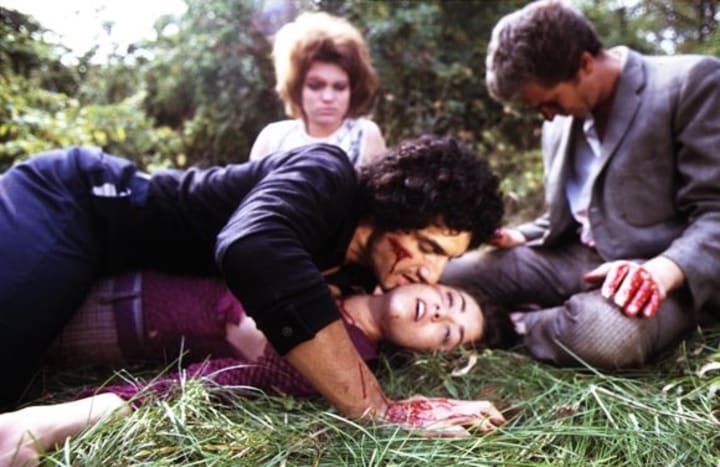
Krug (David Hess) is shown here assaulting Mari (Sandra Cassell) in one of the grisliest, most disturbing scenes from Last House on the Left (1972).
While all of this is going on Doc Collingwood and his wife Estelle are getting the house ready for Mari's return home and birthday bash—they stream a birthday party banner across the room and are shown baking and decorating a cake to happy, bouncy saloon piano playing, while just across the road, the same daughter they are anticipating treating to a celebration is being raped and murdered.
Of course, Mari never makes it home from the concert, and herein the running gag of the bumbling policemen is introduced. (They are played by actors Marshall Anker, as the Sheriff, and David Hess's friend Martin Kove —who most famously went on to star in 1984's hit The Karate Kid—as the hulking, lame-brained deputy).
(Kove was originally tapped to play Krug, but opted instead to turn the role over to Hess, whose sister he was dating at the time).
The two lawmen run out of gas, their squad car stalled, and attempt to make it back to Doc Collingwood's to report that the suspected car carrying the escaped cons—presumably the kidnapped Mari—has been spotted. They are shown attempting to hitch rides, first with some heavy metal hippies (who look as if they could have been roadies for Black Sabbath), and then with an old black woman in a truck full of chickens. Forced to ride on top because of the chicken crates, the two luckless lawmen, quite naturally, fall off into the road at the first screeching stop.
Meanwhile, Krug and company wash up in the creek, donning stolen clothing and tidying themselves up. They make it to the house of their victim, Mari.
Explaining to the worried parents that their car has broke down, they are suave con artists with a bad story that doesn't add up. (They claim to sell insurance for plumbing companies, "You know, in case they steal some toilets or something," explains Sadie, while guzzling the Collingwood's fine port). They are invited, unaccountably, to spend the evening in Mari's room. Junior stays there, dope sick and calling out, while the other three are treated to a spaghetti dinner.
They behave with predictable, uncouth table manners, but the Collingwoods are so worried about their missing daughter that the weirdness of their overnight "guests" never seems to really phase them.
The killers are next shown relaxed, looking drained, lying in their victim's bed, a poster of the ubiquitous peace symbol on the wall above them. Krug laments the bourgeois hangups of their guests ("People in China eating with sticks, and these creeps got sixteen utensils every pea on the plate!") They are all still pulling from the Collingwood's wine stores when Weasel, going over to the mirror, sees some Polaroids.
"Guess who lives here!" he says to Krug, beaming.
Krug responds, "What are the odds of that?"
In the original folk ballad, Tore's Daughters at Varange, it is when the murderous vagabonds try to sell the decorative shifts of their victims to their mother, who instantly recognizes them, that their awful deeds are discovered. In the modern retelling that is Last House, it is when Estelle Collingwood goes to check on the sick Junior, who is suffering withdrawals and is yelling out, that she discovers he is wearing the peace symbol necklace she has given Mari for her birthday. It should be noted that the Peace symbol is an adaptation of Algiz, the "life rune" of the Elder Futhark. Inverted, as the two broken arms of the cross are to form the peace symbol, the rune actually means death, that life is over,
I'm not certain if Craven was aware of this or not, but every character this symbol appears near in the film—Mari, Krug, Weasel, Sadie, and Junior—ends up marked by the more esoteric meaning of the symbol.
What follows is a series of more dream-like happenings, as Estelle and Doc Collingwood go out and find Mari, dead, lying at the side of the pond where Krug killed her. Then, we are shown a dream of Weasel's, who envisions the Doctor and wife dressed in surgical scrubs, standing over him with a hammer and chisel.
They command him to "open wide," then take the chisel to those teeth, causing him to jerk awake. [1] Meanwhile, Doc Collingwood, in keeping with the theme Craven would return to again and again in films such as the original A Nightmare on Elm Street, and The People Under the Stairs, goes about booby-trapping the living room: wiring door handles for electric shock, putting down shaving cream to cause his enemy to slip and fall, etc. He then proceeds to the basement, for the chainsaw.
Weasel wakes up, and Estelle Collingwood is up drinking wine. She quickly pretends to come on to him, and Weasel, an inveterate pervert, accompanies her out in the predawn yard. She asks him if he could, really, make love to someone with his "hands tied behind his back." He brags that "Baby, I am so fantastic, I could literally do it." He lets her secure his hands behind his back with a belt, and she proceed to fellate him.
Doc Collingwood wakes Krug and Sadie with a shotgun blast. Krug puts the bedroom lights out, and everything falls into confusion. Krug predictably slips on the shaving cream booby trap, grasps the electrified door handle, and slides into a couch in his socks. Somehow, though, he gets the gun away from Collingwood. The body of Mari, surrealistically, is lying on the living room couch. Krug observes, "She was tough to kill. Not like you, Doc. You're a real pussy." He punches the older man in the stomach, causing him to double over. It is just then that the feckless, doomed Junior unleashes a volley from Krug's own gun, standing terrified behind him, though he's the only one armed.
We are then treated to the famous scene where Krug literally commands Junior to "Put the gun in your mouth, and BLOW YOUR BRAINS OUT!" He repeats this command several times, and the weak-minded, suicidal Junior obliges. It is just then that Weasel screams, Estelle Collingwood having castrated him with her teeth.
Krug turns to see Doc Collingwood brandishing that iconic horror movie killing machine—the chainsaw, and begins slipping and sliding around the hardwood floor in his socks. Collingwood saws through a table to try and get to Krug; Sadie, having run into the living room brandishing a knife, demonstrates her lack of any loyalty to Krug as she brandishes it at HIM before fleeing out the door.
She is dispatched by Estelle, who is still outside in the early morning sunrise, after using her teeth to tear Weasel's penis off. She slices Sadie's throat, and Sadie dives into the filthy pool, gurgling blood.
The numbskull sheriff and his deputy enter just as Doc Collingwood slices Krug in half with the chainsaw. Both the mother and father then rest, bloodied, and now guilty themselves of murder, resting beneath the birthday party banner they had strung from wall to wall for Mari's party, which never took place.
And the Castle Stays the Same
The cryptic line from the theme, "and the castle stays the same," is metaphorical; or, perhaps it's just nonsense. You could interpret it either way. In the sense of the deeper meaning of this film, of its theme of an America of beauty and innocence, and the denizens of night birthed up to destroy it, and it's further willingness to cast away the white hat of a John Wayne and play as dirty or dirtier than all of its perceived enemies—to give vent to the most bestial urges of revenge, to fight, tooth and claw, to preserve—it means what exactly? Was that prosperity, those white picket fences and green lawns, saccharine television comedies and Fourth of July picnics real, true eternal ideals, timeless iconic images of a land that, for some, seemed to be the earthly side of Heaven? But not for everyone. And what, beneath such an obvious, impermanent and artificial facade, really lurked?
Was it the hard-ass felons and psychopaths that populated Last House on the Left? From what social milieu did they spring? Was it the nightly footage being broadcast home from that war in Vietnam? The famous image of the little girl running down the road, naked, her skin seared by napalm? Was it Agent Orange? Mai Lai? Nixon? Watergate? Was it American blacks being hung from the courthouse steps, in little, brutal Southern sleaze towns rife with corruption and murder? Do tell. Where did those white picket fences and green lawns disappear to?
We despair for that which we have lost, what we perceive has faded into the memory of a yesteryear that has lost all meaning, as archaic as those "video cassette shops" my friend and I use to haunt. The innocence of the Eisenhower Era, the hopefulness of "American Elysium" gave way to the cold war and arms race hysteria, greed, and corruption, and terrorism that marked the Nineteen-eighties. But, even that era and the Nineties and beyond seem quaint, almost homey, compared to the rabbit-hole, dark backward reality of this Unholy Year of Our Lord, Twenty-nineteen.
Last House on the Left is often derided as a highly "immoral" film: although it is impossible to define, precisely, how a work of art might or might not be so judged. It is this author's contention that, far from being a cheap exercise in titillation, Last House on the Left is actually one of the most compelling and moral statements concerning the death of the American dream, as has ever been lensed. It examines its world in a hindsight gaze, and shining through the prism come the environment that birthed Vietnam, Kent State, Woodstock, Manson, LSD, hard rock, lynchings, riots, the Weathermen, and on and on. The Road, damn sure, leads to nowhere; no, the "castle" most certainly did NOT "stay the same."
It's only one brutal, strange crime, but not one so far-fetched its like has never been perpetrated before. Just one random and sickening event. It's also, to borrow from the tagline, "Only a movie." But, it really is so much more than that.
I first saw it with a man who was a Vietnam veteran. He would go on to commit suicide. I had a dream many years later that I am digging through a sort of dust bin when I find an old jean jacket with the sleeves cut out, so it is like a vest. I note it as his. In the pocket, I pull out a medal, maybe a Purple Heart, with his name on it. Sure.
Robert McNamara once asked, in the documentary The Fog of War, "How much evil do you have to do, to do good?" I wouldn't personally know, as I don't believe in "evil"; I believe in force and counter-force, actions and consequences; domination and servitude. But, Last House asks that question, just as assuredly as McNamara: when does the predator become the prey? And when does our desire to do "good" recreate in us the exact monster we are sworn, eternally, to stand vigilant against? When do we take on the animal skin of the beast we so fervently and vehemently despise? And what happens to those Elysium dreams of yesteryear?
Note: [1] According to 10,000 Dreams Interpreted by Gustavus Hindman Miller, a dream of getting your teeth knocked out denotes: "sudden misfortune. Either your business will suffer, or death and accidents will come close to you."
In Weasel's dream, we also, of course, see a foreshadowing of his later death by oral sex castration.
Now we'll finish this little essay by letting the man himself, David Hess, aka "Krug," talk about his music and personal vision for 'Last House on the Left.' RIP Mr. Hess, you will forever embody for me the role and the film you made into a cinematic legend.
About the Creator
Tom Baker
Author of Haunted Indianapolis, Indiana Ghost Folklore, Midwest Maniacs, Midwest UFOs and Beyond, Scary Urban Legends, 50 Famous Fables and Folk Tales, and Notorious Crimes of the Upper Midwest.: http://tombakerbooks.weebly.com
Enjoyed the story? Support the Creator.
Subscribe for free to receive all their stories in your feed. You could also pledge your support or give them a one-off tip, letting them know you appreciate their work.


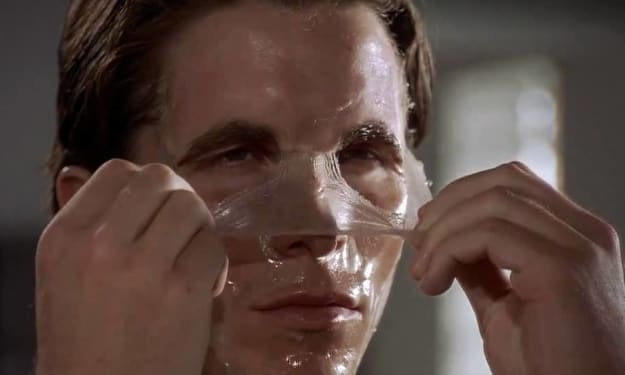
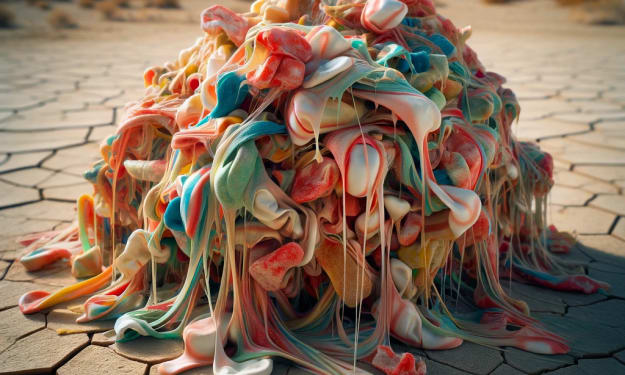


Comments
There are no comments for this story
Be the first to respond and start the conversation.